As to the word rutua it could be a Sign
for Ru-tu'a, the back side of the Lord (Hatu)
of Earthquakes (Nga Rue).
Tua. 1. Back, shoulder, tu'a ivi,
shoulder blade; tu'a ivi more, lumbago;
moa tu'a ivi raá, 'sun-back chicken':
chicken with a yellow back which shines in the
sun. 2. Behind (a locative adverb, used with
i, ki, a, o, etc). Tu'a-papa, pelvis,
hips. Vanaga. 1. Behind, back, rear; ki tua,
after; o tua, younger; taki tua,
perineum. 2. Sea urchin, echinus. The word must
have a germ sense indicating something spinous
which will be satisfactorily descriptive of the
sea urchin all spines, the prawn with antennae
and thin long legs, and in the Maori the shell
of Mesodesma spissa. Tuaapapa,
haunch, hip, spine. Tuahaigoigo,
tattooing on the back. Tuahuri, abortion;
poki tuahuri, abortive child. Tuaivi,
spine, vertebræ, back, loins; mate mai te
tuaivi, ill at ease. Tuakana, elder,
elder brother; tuakana tamaahina, elder
sister. Tuamouga, mountain summit.
Tuatua, to glean. Mgv. tua: To fell,
to cut down. Ta.: tua, to cut. Mq.:
tua, to fell, to cut down. Ma.: tua,
id. Tuaki, to disembowel. Ma.: tuaki,
to clean fish. Tuavera, the last
breadfruit spoiled by the wind. Ta.: tuavera,
burnt by the sun. Churchill.
... When this tremendous task had been
accomplished Atea took a third husband,
Fa'a-hotu, Make Fruitful. Then occurred a
curious event. Whether Atea had wearied
of bringing forth offspring we are not told, but
certain it is that Atea and her husband
Fa'a-hotu exchanged sexes. Then the
[male] eyes of Atea glanced down at those
of his wife Hotu and they begat Ru.
It was this Ru who explored the whole
earth and divided it into north, south, east,
and west ...
Ru. A chill, to shiver, to shudder, to quake;
manava ru, groan. Ruru, fever, chill,
to shiver, to shake, to tremble, to quiver, to
vibrate, commotion, to apprehend, moved, to agitate,
to strike the water, to print; manava ruru,
alarm; rima ruru, to shake hands. P Pau.:
ruru, to shake, to tremble. Mgv.: ru, to
shiver with cold, to shake with fever, to tremble.
Mq.: ú, to tremble, to quiver. Ta.: ruru,
to tremble. Churchill. Mgv.: eager, in haste,
impatient. Ta.: ru, impatience, haste.
Churchill. Ruru, to tremble, an earthquake.
Sa.: lūlū, lue, to shake. To.:
luelue, to roll; lulu, to shake. Fu.:
lulū, to tremble, to shake, to agitate. Niuē:
luelue, to shake; lūlū, to shake, to be
shaken. Nuguria: ruhe, motion of the hands in
dancing; luhe henua, an earthquake. Uvea,
Ha.: lu, lulu, lululu, to
shake, to tremble, to flap. Fotuna: no-ruruia,
to shake. Ma.: ru, ruru, to shake, an
earthquake. Ta., Rarotonga, Rapanui, Pau.: ruru,
to shake, to tremble. Mgv.: ru, to tremble;
ruru, to shake. Mq.: uu, to shake the
head in negation; uuuu, to shake up. Uvea:
ue i, to shake; ueue, to move. Rapanui:
ueue, to shake. Churchill 2.
|
Names for Mercury: |
|
Hawaiian Islands |
Society Islands |
Tuamotus |
New Zealand |
Pukapuka |
|
Ukali
or Ukali-alii
'Following-the-chief' (i.e. the Sun)
Kawela
'Radiant' |
Ta'ero
or Ta'ero-arii 'Royal-inebriate'
(referring to the eccentric and
undignified behavior of the planet as it
zigzags from one side of the Sun to the
other) |
Fatu-ngarue
'Weave-to-and-fro'
Fatu-nga-rue
'Lord of the Earthquake' |
Whiro
'Steals-off-and-hides'; also the
universal name for the 'dark of the
Moon' or the first day of the lunar
month; also the deity of sneak thieves
and rascals. |
Te
Mata-pili-loa-ki-te-la
'Star-very-close-to-the-Sun' |
Another name for the
Earthquake God was Rua(u)-moko:
Rua. 1. Two; second; other (precedes the
noun); te rua paiga, the other side. 2.
Hole, grave; holes in the rocks or between the
rocks of the coastal lagoons; he keri i te
rua, to dig a hole. 3. To vomit. Vanaga. 1.
Two. P Mgv., Ta.: rua, id. Mq.: úa.
2. Nausea, seasickness, to vomit, disgust;
hakarua, to vomit, to spew. PS Mgv.:
aruai, ruai, to vomit. Mq.: úa,
id. Ta.: ruai, id. Pau.: ruaki,
id. Sa.: lua'i, to spit out of the mouth;
lulua, to vomit. To.: lua to
vomit. Fu.: lulua, luaki, id.
Niuē: lua, id. Viti: lua, id.;
loloa, seasick. 3. Cave, hollow, ditch, pit,
hole, beaten path, grave; rua papaka, a
ditch. P Pau.: rua, a hole. Mgv.: rua,
a hole in the ground, ditch, trench. Mq.: úa,
dish, hole, cavern. Ta.: rua, hole,
opening, ditch. Churchill. Ta.: ruahine,
an old woman. Ma.: ruahine, id. Ta.:
ruaroa, tropic of Capricorn. Mq.: uaoa,
a constellation, the eleventh month. The sense
in Tahiti is probably that of some constellation
which may be used to determine the position.
Ta.: ruau, an old man, an old woman. Ha.:
luau, a parent. Churchill.
... They were Ranginui,
the Sky Father, and Papatuanuku, the
Earth Mother, both sealed together in a close
embrace. Crushed between the weight of their
bodies were their many children, whose
oppression deepened. They yearned to be free;
they fought their parents and each other to
break loose. Tuumatauenga, virile god of
war, thrust and shouted; Tangaroa of the
oceans whirled and surged; Tawhirirangimaatea,
Haumiatiketike and Rongomatane, of
wild foods and cultivated crops, tried their
best but were not successful; and Ruamoko,
god of earthquakes, yet to be born, struggled in
the confinement of his mother's womb ... Of them
all, Taane Mahuta [cfr Mahute,
Boussonetia papyrifera], the god of the
forests, was the most determined; he set his
sturdy feet upon his father's chest, and braced
his upper back and
shoulders against the bosom of his mother. He
pushed; and they parted. So the world, as the
Maori understand it, came into being ...
|
 |
|
moko |
... It was an old Maori
belief that a change of seasons was often
facilitated by earthquakes. Ruau-moko, a
god of the Underworld, was said to bring about
changes of season, punctuating them with an
earthquake. Or as another Maori saying summed up
the matter, 'It is the Earth-mother shaking her
breasts, and a sign of the change of season' ...
... Maybe rutu means Ru (is) Tu,
in other words: the season is governed by Ru,
the earthquake god ...
... Muan
must fly in the evening, not in the morning.
Vultures and owls belong to the last phase of
summer, and then follows the 'quake' (16
Ollin):
|
10 |
Ozomatli
(monkey) |
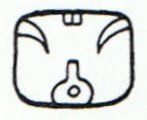 |
Chuen |
monkey |
|
11 |
Malinalli
(grass) |
 |
Eb |
broom |
|
12 |
Acatl
(reed) |
 |
Ben |
reed |
|
13 |
Ocelotl
(jaguar) |
 |
Ix |
tiger, magician |
|
14 |
Cuauhtli
(eagle) |
 |
Men |
bird, eagle |
|
15 |
Cozcacuauhtli
(buzzard) |
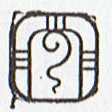 |
Cib |
owl, vulture |
|
16 |
Ollin
(movement) |
 |
Caban |
force, earth |
|
17 |
Tecpatl
(flint knife) |
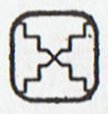 |
Etz'nab |
flint knife |
|
18 |
Quiahuitl
(rain) |
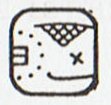 |
Cauac |
storm,
tun |
|
19 |
Xochitl
(flower) |
 |
Ahau |
lord |
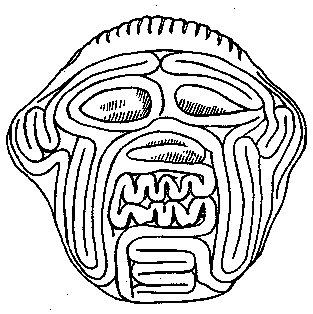
... This terra-cotta mask
shows the unlovely face of Humbaba/Huwawa,
the guardian of the cedar felled by
Gilgamesh and Enkidu. The title of 'God of
the fortress of intestines' is also given to
him, and some scholars conclude from this
title, as well as from the pictorial
evidence, that Humbaba was the inhabitant
and lord of the labyrinth, a predessor of
Minotaurus ...

Somewhere I have read that the reciting of
rongorongo texts took place in the last
quarter of the month, and while reciting the
priests sat down on their buttocks leaning from side to side - they were
'weaving' from side to side (Fatu-ngarue).
... Five days of
illumination, called the 'Lighting of the
Flame' (which in the earlier reading of this
miracle play would have followed the
quenching of the fires on the dark night of
the moon when the king was ritually slain),
preceded the five days of the festival
itself; and then the solemn occasion (ad
majorem dei gloriam) commenced. The
opening rites were under the patronage of
Hathor. The king, wearing the belt with her
four faces and the tail of her mighty bull,
moved in numerious processions, preceded by
his four standards, from one temple to the
next, presenting favors (not offerings) to
the gods.Whereafter
the priesthoods arrived in homage before his
throne, bearing the symbols of their gods.
More processions followed, during which, the
king moved about - as Professor Frankfort
states in his account - 'like the shuttle in
a great loom' to re-create the fabric of his
domain, into which the cosmic powers
represented by the gods, no less than the
people of the land, were to be woven
...
Although Metoro did not read the G tablet for Bishop
Jaussen we have anyhow managed to connect Mercury
with the beginning of its side b:
|
Side a
according to the heliacal Gregorian calendar
has SIRIUS at °June 30 when NUNKI was close
to the Full Moon (cfr Ga2-11).
Side b
at the time of Julius Caesar has SIRIUS at
'June 30 when ROTTEN MELON was close to the
Full Moon (cfr Gb1-18). |
|
NOV 6 |
7 |
8 |
9 (*233) |
10 (314) |
 |
 |
 |
 |
 |
|
Gb1-1
(230 = 2 * 115) |
Gb1-2 |
Gb1-3 |
Gb1-4 |
Gb1-5 |
|
Synodic
cycles |
|
Mercury |
115.88 |
|
Venus |
583.92 |
|
Earth |
364.0 = π *
115.88 |
|
Mars |
779.96 |
|
Jupiter |
398.88 |
|
Saturn |
378.09 |
|
Uranus |
369.66 |
|
|
CLOSE TO THE SUN: |
|
DENEB OKAB
(Tail of the Eagle) =
δ
Aquilae (Ant.)
(294.0),
α VULPECULAE
(Little Fox)
(294.9) |
ν
Aquilae (Ant.) (295.0),
ALBIREO (Ab Ireo) = β Cygni
(295.5) |
ALSAFI (Fire Tripod) =
σ
Draconis
(296.0),
μ
Aquilae (296.3),
ι
Aquilae (Ant.)
(296.8), κ Aquilae (Ant.) (296.9) |
ε Sagittae (297.1), σ Aquilae (Ant.)
(297.4),
SHAM
(Arrow) = α Sagittae
(297.8)
*256.0 = *297.4 - *41.4 |
β Sagittae (298.0), χ Aquilae (298.3), ψ
Aquilae (298.8) |

... In late September or early October 130,
Hadrian and his entourage, among them
Antinous, assembled at Heliopolis to set
sail upstream as part of a flotilla along
the River Nile. The retinue included
officials, the Prefect, army and naval
commanders, as well as literary and
scholarly figures. Possibly also joining
them was Lucius Ceionius Commodus, a young
aristocrat whom Antinous might have deemed a
rival to Hadrian's affections. On their
journey up the Nile, they stopped at
Hermopolis Magna, the primary shrine to the
god Thoth. It was shortly after this, in
October [in the year A.D.] 130 - around the
time of the festival of Osiris - that
Antinous fell into the river and died,
probably from drowning. Hadrian publicly
announced his death, with gossip soon
spreading throughout the Empire that
Antinous had been intentionally killed. The
nature of Antinous's death remains a mystery
to this day, and it is possible that Hadrian
himself never knew; however, various
hypotheses have been put forward. One
possibility is that he was murdered by a
conspiracy at court. However, Lambert
asserted that this was unlikely because it
lacked any supporting historical evidence,
and because Antinous himself seemingly
exerted little influence over Hadrian, thus
meaning that an assassination served little
purpose. Another suggestion is that Antinous
had died during a voluntary castration as
part of an attempt to retain his youth and
thus his sexual appeal to Hadrian. However,
this is improbable because Hadrian deemed
both castration and circumcision to be
abominations and as Antinous was aged
between 18 and 20
[→ 19] at the
time of death, any such operation would have
been ineffective. A third possibility is
that the death was accidental, perhaps if
Antinous was intoxicated. However, in the
surviving evidence Hadrian does not describe
the death as being an accident; Lambert
thought that this was suspicious. Another
possibility is that Antinous represented a
voluntary human sacrifice. Our earliest
surviving evidence for this comes from the
writings of Dio Cassius, 80 years after the
event, although it would later be repeated
in many subsequent sources. In the second
century Roman Empire, a belief that the
death of one could rejuvenate the health of
another was widespread, and Hadrian had been
ill for many years; in this scenario,
Antinous could have sacrificed himself in
the belief that Hadrian would have
recovered. Alternately, in Egyptian
tradition it was held that sacrifices of
boys to the Nile, particularly at the time
of the October Osiris festival, would ensure
that the River would flood to its full
capacity and thus fertilize the valley; this
was made all the more urgent as the Nile's
floods had been insufficient for full
agricultural production in both 129 and 130.
In this situation, Hadrian might not have
revealed the cause of Antinous's death
because he did not wish to appear either
physically or politically weak. Conversely,
opposing this possibility is the fact that
Hadrian disliked human sacrifice and had
strengthened laws against it in the Empire
...
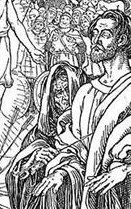 |
|
Jan 9 |
10 (*295) |
11 |
12 |
13 (378 → Saturn) |
|
°Jan 5 (*290 = 370 - 80) |
6 |
7 |
8 |
9 |
|
'Dec 13
(LUCIA) |
14 (*268) |
15 |
16 (350 = 50 weeks) |
17 |
 |
|
"Nov 29 |
30 (*254) |
"Dec 1 |
2 (336 = 48 weeks) |
3 |
|
CLOSE TO
THE FULL MOON: |
|
7 (492 = 4 * 123 = 12 * 41) |
MAY 8 (365 + 2 * 64 = 493 |
9 (*49) |
10 (130) |
11 |
|
ALUDRA (Virgin) = η Canis Majoris
(111.1),
PROPUS = ι Gemini (111.4),
GOMEISA (Water-eyed) = β Canis Minoris
(111.6)
*70.0 = *111.4 - *41.4 |
ρ Gemini (?) (112.1),
Eskimo Nebula = NGC2392 Gemini
(112.2)
ANTARES (α Scorpii) |
Al Dhirā'-5 (Forearm) /
Punarvasu-7 (The Two Restorers of Goods) /
Mash-mashu-Mahrū-10 (Western One of the
Twins)
CASTOR
= α Gemini
*113.4 = *41.4 + *72.0 |
ANA-TAHUA-VAHINE-O-TOA-TE-MANAVA-7 (Pillar
for elocution)
υ Gemini (114.0),
MARKAB PUPPIS = κ Puppis
(114.7), ο Gemini (114.8),
PROCYON
= α Canis Minoris
(114.9) |
α Monocerotis
(115.4), σ Gemini (115.7)
*74.0 = *115.4 - *41.4 |
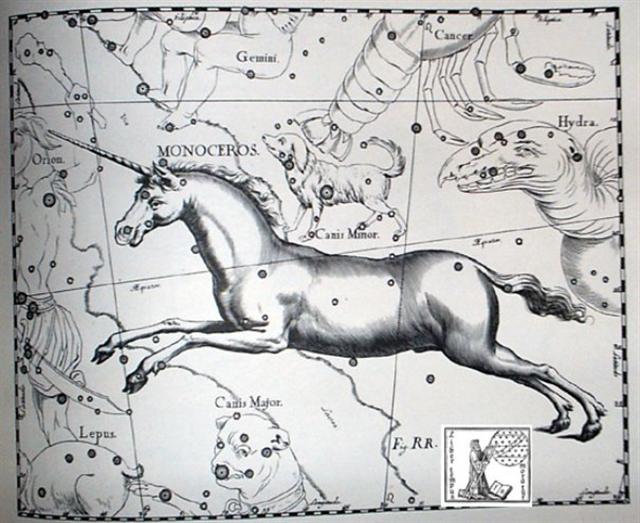 |
|
July 10 |
July 11 |
12 (193) |
13 |
14 (*480) |
|
°July 6 |
7 (188) |
8 |
9 |
10 (*111) |
|
'June 13 |
14 |
15 (166) |
16 |
17 (*88) |
|
"May 30 |
31 |
Te Maro 1 (8 * 19) |
"June 2 |
3 (*64) |
|
... On the twenty-fifth day of the first
month (Vaitu Nui), Ira and
Makoi set sail; on the first day of June
('Maro'), the bow of Ira's
canoe appeared on the distant horizon, came
closer and closer on its course, and sailed
along, and finally (one) could see the (new
home) land ... (E:17) |
 |
 |
 |
 |
 |
|
Ga2-17 |
Ga2-18 |
Ga2-19 |
Ga2-20 (50) |
Ga2-21 |
|
NOV 11 (315) |
12 (*236 = 472 / 2) |
13 |
 |
 |
 |
|
Gb1-6 (235) |
Gb1-7 |
Gb1-8 |
|
CLOSE TO THE SUN: |
|
υ Aquilae (299.1),
TARAZED (Star-striking Falcon) = γ
Aquilae
(299.3), δ Sagittae (299.6), π Aquilae
(299.9) |
Sravana-23 (Ear or Three Footprints)
TYL =
ε
Draconis
(300.0),
ζ
Sagittae (300.1),
ALTAIR
(Flying Eagle) =
α
Aquilae
(300.3),
ο
Aquilae (300.5),
BEZEK =
η
Aquilae
(Ant.)
(300.8) |
ι Sagittarii (301.2),
TEREBELLUM = ω Sagittarii,
ξ Aquilae (301.3),
ALSHAIN (Falcon) = β Aquilae
(301.6), φ Aquilae (301.8) |
 |
|
Jan 14 |
15 (*300) |
16 (381) |
|
°Jan 10 (*295) |
11 |
12 (377) |
|
'Dec 18
(*272) |
19 |
20 (354 = 12 * 29½) |
|
"Dec 4 |
5 (339) |
6 (*260) |
|
CLOSE TO THE FULL MOON: |
|
MAY 12 (*52) |
13 (133) |
14 |
|
Mash-mashu-arkū-11 (Eastern One of the
Twins)
κ Gemini (116.1),
POLLUX
= β Gemini
(116.2), π Gemini (116.9) |
AZMIDISKE = ξ Puppis
(117.4)
*76.0 = *117.4 - *41.4 |
φ Gemini (118.4)
*77.0 = *118.4 - *41.4 |
|
July 15 (196) |
16 (*482) |
17 (*118) |
|
°July 11
(192) |
12 (*478) |
13 (*114) |
|
'June 18
(*454) |
19 (170) |
20 (*91) |
|
"June 4
(*440) |
5 (156) |
6 (*77) |
 |
 |
 |
|
Ga2-22 |
Ga2-23 |
Ga2-24 |
And with help from Manuscript E (E:17) we can
find Mercury at the beginning of the voyage of
the Explorers (planets), because at the time of
Bharani (the place of birth) "April 25 (115 →
Mercury) was at Cursa (the 'footstool' of Rigel
- the right foot of Orion):
|
tagata tuu rima ki ruga |
te
maitaki |
te
henua |
Rei hata
ia |
tagata rogo |
|
... the first
month of the Moriori year, was named
Rongo (Lono). On the
first of the new year the Moriori
launched a small canoe to Rongo,
although they built and used only
rude craft for their fishing
excursions. The canoe was manned by
twelve figures symbolizing the
personifications of the twelve
months. Sometimes twenty-four
figures were placed in the canoe,
and Skinner interprets the
additional twelve as representing
the female counterparts of the
months. As an old Maori once
remarked. 'Everything has its female
counterpart
...
|
 |
|
Rogo |
|
 |
 |
 |
 |
 |
|
Ca3-21 (→ March 21 → Gregorian
equinox) |
Ca3-22 (73) |
Ca3-23 |
Ca3-24 |
Ca3-25
(→ March 25→ Julian equinox) |
|
Hata.
1. Table, bureau. P Pau.:
afata, a chest, box. Mgv.:
avata, a box, case, trunk,
coffin. Mq.: fata, hata,
a piece of wood with several
branches serving as a rack, space,
to ramify, to branch; fataá,
hataá, stage, step, shelf.
Ta.: fata, scaffold, altar.
2. Hakahata, to disjoint;
hakahatahata, to loosen, to
stretch. P Pau.: vata, an
interval, interstice. Mgv.:
kohata, the space between two
boards, to be badly joined;
akakohata, to leave a space
between two bodies badly joined;
hakahata, to be large, broad,
wide, spacious, far off. Mq.:
hatahata, fatafata,
having chinks, not tightly closed,
disjointed. Ta.: fatafata,
open. 3. Hatahata, calm,
loose, prolix, vast. Mgv.:
hatahara, broad, wide, spacious,
at one's ease. Ta.: fatafata,
free from care. Mq.: hatahata,
empty, open. 4. Hatahata,
tube, pipe, funnel. Churchill. Sa.:
fata, a raised house in which
to store yams, a shelf, a
handbarrow, a bier, a litter, an
altar, to carry on a litter;
fatāmanu,
a scaffold. To.: fata,
a loft, a bier, a handbarrow, to
carry on a bier; fataki,
a platform. Fu.: fata,
a barrow, a loft; fatataki,
two sticks or canes attached to each
other at each side of a house post
to serve as a shelf. Niuē:
fata,
a cage, a handbarrow, a shelf, a
stage, (sometimes) the upper story
of a house. Uvea: fata,
a barrow, a bier. Fotuna:
fata,
a stage. Ta.: fata,
an altar, a scaffold, a piece of
wood put up to hang baskets of food
on; afata,
a chest, a box, a coop, a raft, a
scaffold. Pau.: fata,
a heap; afata,
a box, a chest. Ma.: whata,
a platform or raised storehouse for
food, an altar, to elevate, to
support. Moriori: whata,
a raft. Mq.: fata,
hata,
hataá,
shelves. Rapanui: hata,
a table. Ha.: haka,
a ladder, an artificial henroost;
alahaka,
a ladder. Mg.: ata,
a shelf; atamoa,
a ladder; atarau,
an altar. Mgv.: avata,
a coffer, a box. Vi.: vata,
a loft, a shelf; tāvata,
a bier. The Samoan fata
is a pair of light timbers pointed
at the ends and tied across the
center posts of the house, one in
front, the other behind the line of
posts; rolls of mats and bales of
sennit may be laid across these
timbers; baskets or reserved
victuals may be hung on the ends.
The litter and the barrow are two
light poles with small slats lashed
across at intervals. The Marquesan
fata
is a stout stem of a sapling with
the stumps of several branches, a
hat tree in shape, though found
among a barehead folk. These
illustrations are sufficient to show
what is the common element in all
these fata
identifications, light cross-pieces
spaced at intervals. With this for a
primal signifaction it is easy to
see how a ladder, a raft, a
henroost, an altar come under the
same stem for designation. Perhaps
Samoan fatafata
the breast obtains the name by
reason of the ribs; it would be
convincing were it not that the
plumpness of most Samoans leaves the
ribs a matter of anatomical
inference. Churchill 2. ...
Teke said to Oti, 'Go
and take the hauhau tree, the
paper mulberry tree, rushes,
tavari plants, uku koko
grass, riku ferns, ngaoho
plants, the toromiro tree,
hiki kioe plants (Cyperus
vegetus), the sandalwood tree,
harahara plants, pua
nakonako plants, nehenehe
ferns, hua taru grass,
poporo plants, bottle gourds (ipu
ngutu), kohe plants,
kavakava atua ferns, fragrant
tuere heu grass, tureme
grass (Diochelachne sciurea),
matie grass, and the two
kinds of cockroaches makere
and hata.'
... The division into
quarters of a 28-series can be
applied to the main phases of the
moon during the visible period as
was as to a (reflex of the old
world?) sidereal month.
The separate subgroup (29
makere - 30 hata)
consists of the names of two types
of cockroaches, but in related
eastern Polynesian languages these
names can also be explained on a
different level. MAO. makere,
among others, 'to die', and whata,
among others, 'to be laid to rest on
a platform', deserve special
attention.
The theme hinted at is one of
death and burial. In our scheme they
occur at just that time when the
moon 'has died'! This lends further
support to the lunar thesis.
Barthel 2.
 |
|
CLOSE TO THE FULL MOON: |
|
June 1 (152) |
2 |
3 |
4 |
5 |
|
π4 Orionis (72.1), ο¹ Orionis
(72.4), π5 Orionis (72.8)
*31.0 = *72.4 - *41.4 |
π¹ Orionis (73.0), ο² Orionis
(73.4),
HASSALEH = ι Aurigae
(73.6), π6 Orionis (73.9)
*32.0 = *73.4 - *41.4 |
ALMAAZ (The Male Goat) = ε Aurigae
(74.7),
HAEDUS I = ζ Aurigae
(74.8) |
HAEDUS II = η Aurigae
(75.9) |
5h (76.1)
ε Leporis (76.0),
CURSA
= β Eridani
(76.4), λ Eridani (76.7)
*35.0 = *76.4 - *41.4 |
|
"April 21 (111) |
22 |
23 |
24 |
Vaitu Nui 25
(115) |
|
DAY 72 |
73 (= 365 / 5) |
74 |
75 |
76 |
 |
|
CLOSE TO THE SUN: |
|
Dec 1 |
2 |
3 |
4 |
5 |
|
Ophiuchi (255.3),
GRAFIAS (Claws) = ζ Scorpii
(255.4) |
κ
Ophiuchi (256.2),
ζ
Arae (256.5),
ε
Arae (256.8),
CUJAM
(Club) = ε Herculi
(256.9) |
no star listed (257) |
17h (258.7)
ARRAKIS = μ Draconis
(258.7) |
Mula-19 (The Root)
SABIK (The Preceding One) = η
Ophiuchi
(259.7), η Scorpii (259.9) |
 |
|
DAY 255 |
256 (= 4 * 64) |
257 |
258 |
259 |
|
kua tupu te rakau |
kua tupu - te
kihikihi |
te
hau tea |
 |
 |
 |
|
Ca4-1 (77) |
Ca4-2 |
Ca4-3 |
|
CLOSE TO THE FULL MOON: |
|
μ Aurigae, μ Leporis (77.6) |
ĸ Leporis (78.0),
RIGEL
(Foot) = β Orionis
(78.1),
Flaming Star = IC405
(78.2),
CAPELLA
= α Aurigae
(78.4), ο Columbae, τ Orionis (78.8)
*37.0 = *78.4 - *41.4
THUBAN
(α Draconis)
|
λ Aurigae (79.0), λ Leporis (79.6),
ρ Aurigae (79.7)
ARCTURUS (α Bootis)
|
|
June 6 (157 = 314 / 2) |
7 (*78) |
8 (4 * 29½ + 41) |
|
DAY
77 (11 weeks) |
78
(= 3 * 26) |
79
→ northern spring equinox |
|
CLOSE TO THE SUN: |
|
Dec 6 (340 = 157 + 183) |
7 (*261 = *78 + *183) |
8 |
|
DAY 260 |
261 (= 9 * 29) |
262 |
Te Kihikihi could have have referred to a time
of ashes, because with slash-and-burn
agriculture this implies a new growth ahead.

Rehua (Antares) is a name which
similarly refers to ashes (and the grey
colour of early dawn).
Rehu. 1. Dust. P Mgv.: rehu, a
cinder, coal, ashes. Mq.: éhuahi,
ashes. Ta.: rehu, ashes, soot, any
powder. 2. To omit, to forget, to faint.
Rehurehu, to omit, omission, lost to
sight. Hakarehu, to surprise.
Rehua, unintelligible. Churchill. Mgv.:
rehurehu, from early dawn to mid
morning. Ta.: rehurehu, twilight.
Mq.: ehuehu, id. Churchill. Mq.:
ehu, to fall in bits. Ma.: rehu,
to split off in chips. Ehua, Ehuo,
a large constellation. Ma.: rehua, a
star or planet, probably Jupiter. Churchill.
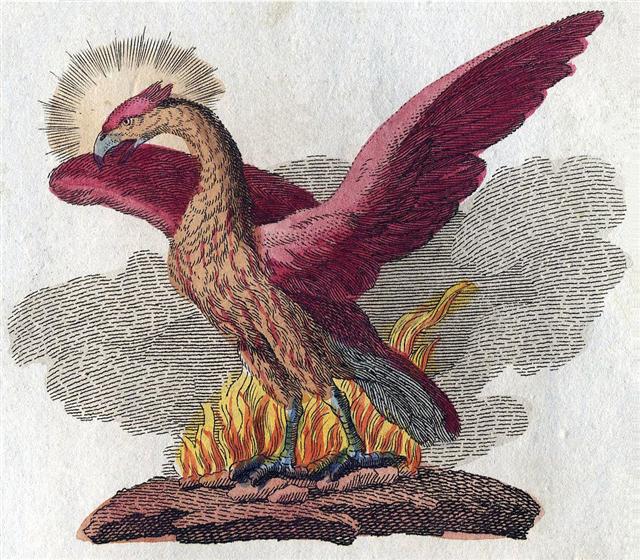
... Before I had time to
take notes the information was gone from my
TV screen. But what remains in my memory
must be retold. There was somewhere among
the 'Paradise Islands' - which ought to have
been located close to New Guinea where the
birds of paradise once were thriving - a
species which I think might have been the
origin of the mythical Phoenix. It laid a
single great white egg and after some time
(27 days if I remember it right) a rather
fully grown chicken emerged from the ashes
in which his mother had dug a properly
located hole. This hole had to be on the
slope of an active volcano and the
temperature in the hole she had dug with her
powerful feet down into the ashes had to
keep a temperature close to 95º Fahrenheit.
His mother had fought with other such birds
in order to secure a good hole which had
exactly the right temperature for hatching
out her offspring. Unfortunately I cannot
recall with certainty what the name of this
species was, but the bird was sooty black
all over and looked rather similar to a
raven. Later I investigated further by way
of the internet and concluded that this bird
born from the ashes ought to be a close
relative to the greater of the Melampitta
pair (i.e. Megalampitta giganteus) -
a curious character who has its nest down in
limestone sinkholes and who has stubby wings
from climbing up and down the walls inside
such a hole ...
|







































